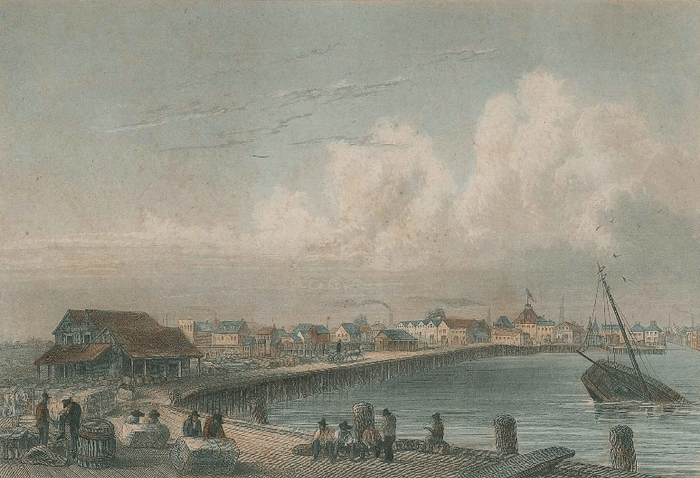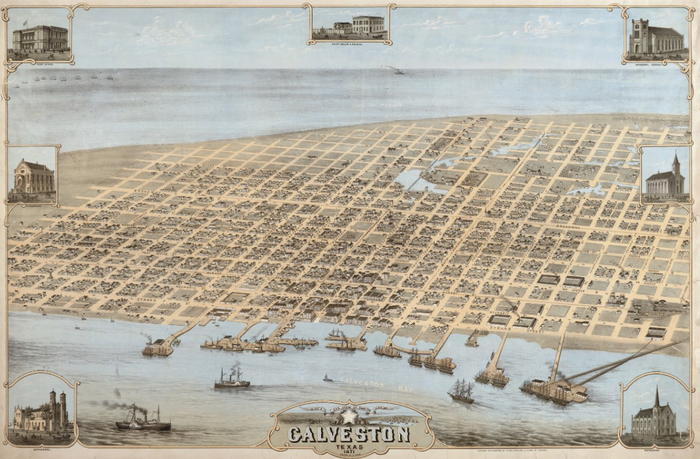At the bleakest moment in Galveston’s
history, when the stench of death was covered only by the smoke of funeral
pyres, when a 20-foot-high, 8-mile-long debris wall - all that remained of the
southern half of the island - loomed over downtown, at a time when the joy of
reuniting with a loved one was cruelly tempered by the loss of a dozen others,
news outlets around the country were quick to proclaim that “Galveston was
finished.” No city could survive the magnitude of the destruction left behind
by that September storm.
They
had forgotten that Galveston
was not a city of mere mortals, it was a city of dreamers, renegades,
trailblazers, and die-hards. The naysayers neglected to realize that everything
that had transpired upon the shores of the island city since its 1839 inception
was not mere luck nor chance, but rather, an outpouring of an unexplainable,
intangible force of unyielding determination, a magnetism forged by a
collective genius, creativity, and ambition.
The rapid and vast commercial successes borne from this incubator in the
19th Century were looked upon by outsiders with both awe and
contempt, especially as the bravado manifested itself by way of a
mansion-building contest along Broadway
Avenue and a downtown replete with architectural
masterpieces. However, what were seen by some as ostentatious displays of
wealth were in fact a people giving back to their benefactor, installations of
jewels upon the crown of the Queen
City of the Gulf.
But
only now, as Galveston
suffered in agony at the hands of her nemesis Mother Nature, was the unseen
force behind the city’s meteoric rise given a name. Surrounded by rubble and
ruin, facing a population stricken by the pain of the recent past and fear for
the future, Isaac H. “Ike” Kempner declared that “The Spirit of Galveston”
would prevail.
This
spirit had given the island its paradisiacal status, not the water or the
weather, just as it had catapulted Galveston
from a modest trading post to a thriving port of international commerce. It was
the spirit that would lift the city from tragedy to affluence as it had once
before, and as it would again and again.
Galveston was still an
infant city the first time that uncontrollable circumstances overshadowed its
natural proclivity for prosperity. When the nation fractured in 1861, a federal
blockade was launched against all southern seaports, crippling Galveston’s burgeoning economy. A handful of
daring businessmen maneuvered the Civil War situation with blockade runners,
but the remainder of the population evacuated their island home as it became
consumed with military activity.
As
the closest port city to Mexico,
a Union ally, Galveston
was viewed as a strategic piece of the supply chain. In late 1862, northern forces
wrestled control from their southern counterparts, but with a surprise attack
during the early morning hours of New Year’s Day 1863, known historically as
the Battle of Galveston, the Confederacy regained control and maintained it for
the duration of the war.
During Restoration, Galveston
patiently endured the interference of the federal government and subsequently
managed to outpace almost every other southern city with its rapid rebound.
This feverish quest for economic dominance continued unfettered for the rest of
the 19th century, elevating Galveston’s
commerce to a level that surpassed even that of New Orleans.
The
population was the second wealthiest (per capita) in the nation, just beneath
that of Newport, Rhode Island, home of the Vanderbilt
dynasty. Equally as important to the city’s fabric was its port of immigration
that once surpassed Ellis Island.
This widespread and multi-faceted international influence enlivened the
city census to reflect an eclectic mix of nationalities and infused the town
with diversity. Among the open-minded population, who lived in unrestricted and
unsegregated residential areas, a person’s only meaningful designation was that
of “islander.”
Indeed,
only a population galvanized by this social and economic success, as well as
the pride elicited by such an accomplishment, was strong enough to embrace the
overwhelming task of recovering from the 1900 Storm. Interestingly, most
historians deny Galveston
this, its grandest achievement, and instead the storm is often named as the
ultimate abdication of its sovereignty. But the city did not merely rebuild
structures, it literally raised itself to new heights.
Determined to never let future generations of islanders endure such a
hardship and emboldened by The Spirit of Galveston, the city on a sandbar
enacted what is still today considered one of the most significant feats of
civil engineering ever accomplished in the history of the United States.
They built a 17-foot-high barricade against the sea and elevated the southern
half of the island an average of 13 feet; the original seawall and ensuing
grade-raising took nearly a decade to complete.
 Meanwhile
on the northern shore, the Port
of Galveston was endowed
with the most technologically advanced wharf in the world where it continued to
shatter records of importation and exportation set prior to the storm.
Meanwhile
on the northern shore, the Port
of Galveston was endowed
with the most technologically advanced wharf in the world where it continued to
shatter records of importation and exportation set prior to the storm.
When at last its commerce was overtaken in 1914 with the opening of the
Houston Ship Channel, Galveston
yet again refused to cower amid adversity. The sense of invincibility fostered
by its early success and superlative recovery created the ideal conditions for
the city to unofficially declare itself “The Free State of Galveston.”
Continuing
as it had previously, undaunted by outside opinion, the city chose to again
play by its own rules - even if that meant changing the game. The eventual and
ugly demise of the Free State has relegated
this era of Galveston
history to the bottom of the heap, but that does not erase the fact that this
era is perhaps the most potent example of The Spirit of Galveston.
The
winners write history, which is why few people know about a certain coastal
community’s ability to transform the non-violent, victimless “crimes” of vice
into a famed national reputation for glamour, luxury, and elegance that removed
Galveston from
of the atrocities of war and depression. These same sins, for which the city
paid dearly in 1957 with a violent and nationally embarrassing takedown at the
hands of self-serving state officials, are the ones that today have made Las
Vegas an international sensation.

It seemed at the time that The Spirit of Galveston had been
rendered extinct, both sunken and set ablaze like the confiscated slot machines
that were once as ubiquitous as the mindset that had installed them in every
drugstore and washateria in town. Then Hurricane Carla (1961) grabbed the city
by the shoulders and shook it admonishingly, reminding Galveston that the spirit could be buried,
but it would never die. Although they no longer exist, the prominent
accomplishments of the decade after Carla, namely the Flagship Hotel and
Sea-Arama, marked the island’s entrance into a new era that has yet to be named
but continues to evolve.
Weakened from a century of hardship, Galveston finally seemed willing to succumb
to the opinion imposed onto it from the outside - that it had always and would
always be worthy only of beach-town status, laden with family-friendly
entertainment for the rest of the world to enjoy, even if it was not a true
embodiment of the city’s values. Thus, although the spirit had been renewed, it
limped along with apathy at the task set before it.
At
last in the 1980s, a hometown boy turned oil magnate lit the spark that
continues to burn. Perhaps the singular definer of the modern spirit, George
Mitchell started the conversation that was finally brought to the forefront
after Hurricane Ike again tested the city’s strength - Galveston is more, so much more, than a beach
town.
 Just
ask one of the hundreds of artists, small business owners, or non-profit
organizations who have breathed life into Galveston’s
historic downtown, or one of the thousands of historic homeowners who have
personally invested in immortalizing island history. They will tell you that
the vibrant and exponential growth over the last ten years has nothing to do
with a coat of paint, a new building, or a repaved sidewalk.
Just
ask one of the hundreds of artists, small business owners, or non-profit
organizations who have breathed life into Galveston’s
historic downtown, or one of the thousands of historic homeowners who have
personally invested in immortalizing island history. They will tell you that
the vibrant and exponential growth over the last ten years has nothing to do
with a coat of paint, a new building, or a repaved sidewalk.
They will tell you, or rather show you, that
The Spirit of Galveston is alive and well.